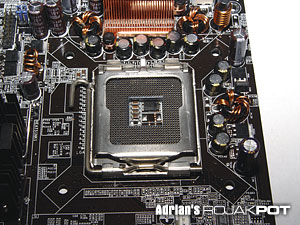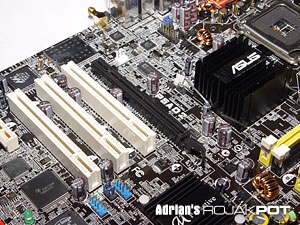Socket LGA775
This brand new socket represents the most radical shift in socket design since the introduction of the ZIF (Zero Insertion Force) socket over a decade ago!
At first glance, the new socket looks like the undersides of old PGA processors.
You have probably heard a lot of stories about how badly designed the new socket
is. Well, the LGA775 socket in the ASUS P5AD2 Premium comes with a plastic cover
to protect the pins from getting bent during handling. Of course, you will need
to remove this cover to install the processor! ![]()
The old PGA478 socket was famous for allowing the processor to get pulled off whenever someone pulls the heat sink off too fast/hard. This was due to the PGA478 packaging with its short pins. The short pins provided little grip for the socket, thus allowing the processor to be easily pull out from the socket.
However, the new LGA775 was designed to correct that problem. If the LGA775 processor is placed carefully into the socket, it will be firmly locked into place. The new LGA775 design won't allow the processor to be pulled off the socket anymore. Personally, I prefer this new socket to the old PGA socket.
PCI Express x16
The next addition to this new platform is the much hyped PCI Express x16 bus which completely replaces the AGP 8X port. Boasting a peak bandwidth of 8GB/s bi-directionally, it will be a lot faster than AGP 8X which peaks out at just 2.1GB/s.
But just how much real world improvement will all that numbers translate into? Remember, the AGP 8X isn't even close to being saturated by current cards with their huge memory buffer. True enough, it has been proven that PCIe x16 currently offers no performance improvement over AGP 8X.
However, PCI Express, formerly known as 3GIO (3rd Generation I/O), has a few distinct advantages over the old AGP port. For example, it allows a higher bandwidth per pin, a serial connection and the ability to provide up to 75W of power to the graphics card!
With that said, high-end PCIe cards will still need additional power supply from a new 6-pin power connector.
<<< The New Intel i9x5 Chipsets : Previous Page | Next Page : Dual Channel DDR2 Memory Controller >>>







 Add to Reddit
Add to Reddit



